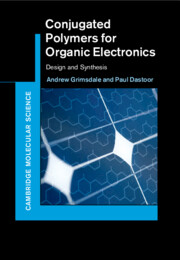Book contents
- Conjugated Polymers for Organic Electronics
- Cambridge Molecular Science
- Conjugated Polymers for Organic Electronics
- Copyright page
- Contents
- Preface
- Abbreviations
- 1 Introduction
- 2 Polyacetylenes
- 3 Poly(arylene vinylene)s
- 4 Poly(arylene ethynylene)s
- 5 Poly(phenylene)s
- 6 Polyfluorenes and Related Polymers
- 7 Polythiophenes
- 8 Other Arylene-Based Polymers
- 9 Hyperbranched Polymers, Star Polymers and Dendrimers
- 10 Polymers with Molecular-like Chromophores
- 11 Polymers for Phosphorescent LEDs
- 12 Polymers for White-Emitting PLEDs
- 13 Polymers for Other Luminescent Devices
- 14 Conclusion and Outlook
- References
- Index
3 - Poly(arylene vinylene)s
Published online by Cambridge University Press: 28 March 2024
- Conjugated Polymers for Organic Electronics
- Cambridge Molecular Science
- Conjugated Polymers for Organic Electronics
- Copyright page
- Contents
- Preface
- Abbreviations
- 1 Introduction
- 2 Polyacetylenes
- 3 Poly(arylene vinylene)s
- 4 Poly(arylene ethynylene)s
- 5 Poly(phenylene)s
- 6 Polyfluorenes and Related Polymers
- 7 Polythiophenes
- 8 Other Arylene-Based Polymers
- 9 Hyperbranched Polymers, Star Polymers and Dendrimers
- 10 Polymers with Molecular-like Chromophores
- 11 Polymers for Phosphorescent LEDs
- 12 Polymers for White-Emitting PLEDs
- 13 Polymers for Other Luminescent Devices
- 14 Conclusion and Outlook
- References
- Index
Summary
The methods for synthesising by precursor routes films of insoluble poly(phenylene vinylene) (PPV), the prototypical poly(arylene vinylene) (PAV) are described and compared and its properties discussed. Methods for preparing soluble substituted PPVs are described and their structure–property relationships discussed. By suitable choice of structure, PAVs with emission colours ranging from the blue to the near infra-red have been made and tested in light-emitting diodes. The choice of substituents has also been used to enhance the charge accepting and transporting properties of PAVs, thus improving their efficiency in devices. The efficiency of polymer-based LEDs is also affected by the presence of defects in the polymer structures and methods have been developed to minimise these, enabling commercially-viable LEDs to be made using PAVs. The potential use of PAVs in OTFTs and OPVs is also discussed.
- Type
- Chapter
- Information
- Conjugated Polymers for Organic ElectronicsDesign and Synthesis, pp. 29 - 53Publisher: Cambridge University PressPrint publication year: 2024



